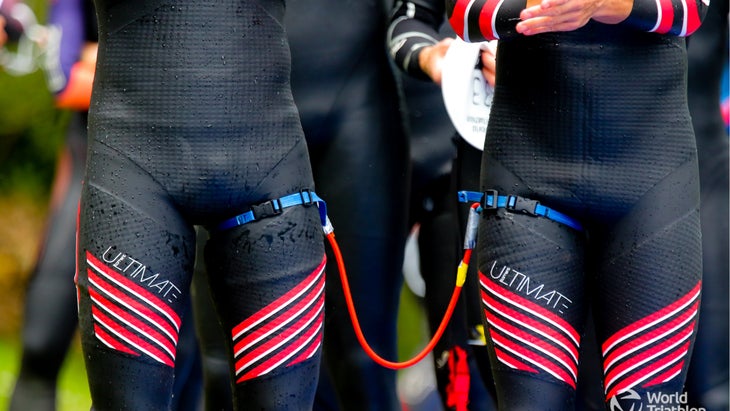New perk! Get after it with local recommendations just for you. Discover nearby events, routes out your door, and hidden gems when you sign up for the Local Running Drop.
Paratriathlon’s second Paralympic appearance promises two days of world-class action as the best in the sport compete in eight races over the sprint distance in Tokyo’s Odaiba Bay.
RELATED: What is Paratriathlon? Understanding Triathlon in the Paralympics
While the finest physically and visually impaired triathletes vie for medals, a range of custom-made equipment will also be on show at this year’s Paralympics, as competitors bid to gain the vital seconds that lead to glory.
Before the action begins, Triathlete wanted to give members a close look at the specialized and unique equipment Paralympians will use (and even how much it costs) in the tri events, so we turned to British Paratriathlon head coach Jonny Riall.
Riall has lived and breathed paratri for more than a decade, he’s led his squad to an impressive gold, two silvers, and a bronze at the Rio Games, and with eight paratriathletes in Tokyo, is hoping to do even better this weekend.
“Paratriathlon is non-drafting, so immediately you’re into time trials and the ever-evolving technology concerning aerodynamics,” Riall explained. “You’d probably compare it closer to Ironman than Olympic triathlon—the range of equipment across the categories is massive.”
We’ll look at the hardware used for the wheelchair racers (PTWC), ambulant classes (PTS2 to PTS5), and visually impaired and blind triathletes (PTVI), and while at times it can seem prohibitively expensive, Riall believes that at Paralympic level two-thirds of racers will be supported by sponsors, and no athlete’s performance will be limited by equipment.
PTWC – Wheelchair class
Handcycle/Handbike
The handcycle is used for the 20K “bike” leg in the PTWC class. “People get confused between handcycles and racing chairs,” Riall said. “An easy way to explain it is that handcycles have gears like bicycles, and racing chairs don’t. For a handcycle, imagine turning a normal bike upside down and holding the pedals rather than putting your feet on them.”
Handcycles use much of the same materials and technology as bicycles, such as full carbon frames (made from one piece if possible) and electronic gearing. Brakes are integrated with the pedals, and custom-made hand grips act like a neatly fitting cleat.
Aerodynamics are also important. Back wheels are shrinking and becoming more pitched in, increasing the rolling resistance but saving on wind resistance, and for Tokyo Team GB even worked on an integrated cooling system in the seat (though now abandoned) to help manage the heat.
Estimated cost for a top-of-the-range handbike with wheels: $13k-$16k
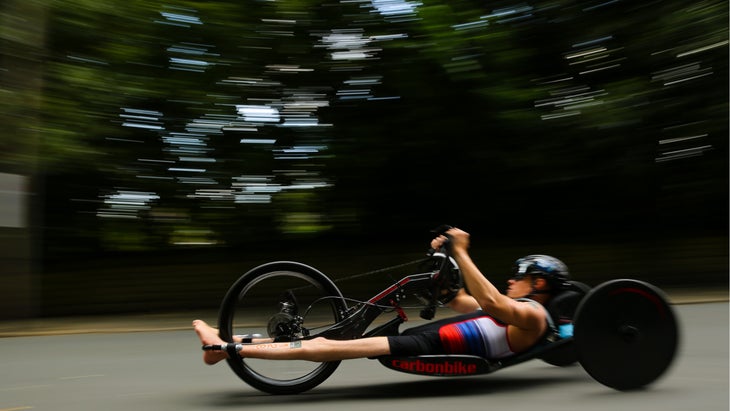
Racing chair
Athletes have long since swapped racing regular day-chairs for high-tech carbon alternatives with disc wheels, but paratri’s final leg is still relatively pure sport.
“The gear is set by the circumference of the push rims,” Riall explained. “The bigger the circumference, the easier it is to start pushing, but once moving, smaller push rims give more bang for your buck.” The length of the athlete’s arms dictates how hard a gear they’ll push, with contact typically made at the bottom third of the rim.
“It’s incredibly technical,” Riall explained. “It’s about hand placement and the subtle movement of your wrist. When the race chair is moving at 18mph and you’ve 0.3 seconds of contact time to keep the wheel spinning faster, your hand action has to be perfect.”
Customized gloves with a molded plastic groove that aligns for contact with the push rim are preferred over old-style harness gloves that strap to the hand—similar to boxing gloves. The latter are more forgiving, but have been phased out of triathlon due to the time it takes to put them on in transition.
Estimated cost: $10k-$12k
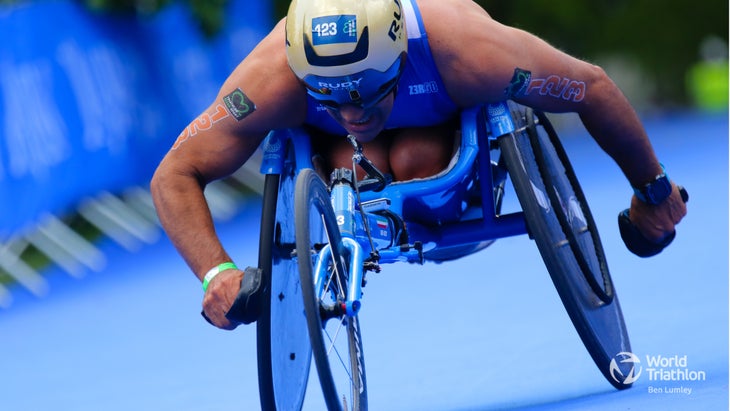
PTS2- PTS5 – Ambulant classes
Leg and arm prostheses used in ambulant classes are not category specific and different styles of blades, arm attachments, and braces are used depending on the athlete’s needs and preferences.
Prostheses generally attach by suction. There’s a one-way valve that lets the air escape that ensures the carbon limb sticks to the amputation area. It must be a comfortable, snug fit, which can take time and expense to get right. Since blades can wear out, they tend to come in two parts so if a blade breaks the suction cup doesn’t have to be replaced as well.
Leg blades & braces
Leg blades on the bike are often rigid carbon structures in a tear-drop shape with a cleat to try to maximize both aerodynamics and power transfer through the pedal stroke.
For the run, above-the-knee amputees have two choices: The USA’s Melissa Stockwell, who placed third in Rio, chooses to have a blade that operates in a circular motion from the hip, whereas GB’s Paralympic champion Andy Lewis opts for a more straight up and down running motion, using an artificial knee joint.
“As with running shoes, blades come in different levels of stiffness and it’s entirely dependent on the type of runner,” Riall explained. “A runner with a quick turnover and not much contact time might want a stiff, sprinter’s blade, but distance athletes’ blades tend to have slightly more give for comfort.”
As well as speed on the bike and run legs, the choice of blade can be dictated by how quickly it allows a paratriathlete to exit transition. For example, France’s PTS4 Tokyo gold-medal favorite Alexis Hanquinquant prefers a single blade solution of a running blade with a built-in cleat, confident the power and time he loses on the bike will be made up by a faster T2.
Not all athletes wear blades. Depending on their disability, some might attach a lower leg brace. Riall gives the example of British PTS2 2019 world champion Fran Brown who has partial paralysis. “Fran can’t plantar flex her foot,” he said. “The only way to keep it in position is a brace. They are custom-made and tend to get a lot of wear and tear, so a sponsor partner might provide four-to-five sets for a year.”
Much of the expense of blade and prostheses is tied to the customized molding process and athletes usually develop long relationships with specialist providers.
Estimated cost for a custom socket and blade: $4-6k
RELATED: How Red Tape Keeps Amputee Athletes Out of Sport
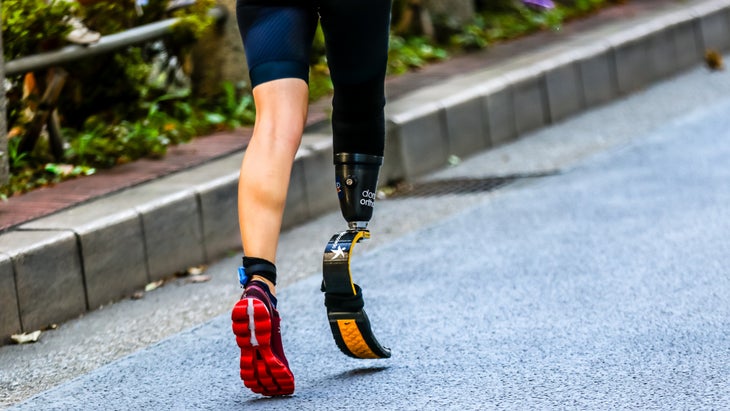
Arm prostheses
Primarily used for cycling, arm prostheses could be used for the run leg too. In theory. “We’ve never seen anyone take them on to the run, but it doesn’t have to be the case,” Riall said, explaining how para sprinters use arm prostheses to help drive forward down the track. “Rather than make it light, they try to make it as heavy as the other arm.”
Safety is the first consideration, with the prosthesis allowing for a balanced ride and technical sections of a bike course to be negotiated. Once the triathlete is comfortable, more aerodynamic positions can be considered.
Riall gives contrasting examples of Claire Cashmore and Lauren Steadman, GB triathletes who are both medal favorites in the PTS5 class in Tokyo.
Cashmore has two suction cup adaptations to her handlebars. A higher one to place her amputation area into while riding on the hoods, and a lower cup for when she’s riding in a time-trial position. In contrast, Steadman hasn’t made alterations to her bike and favors a standard replica forearm received from the British National Health Service.
“Lauren says if an arm is good enough for me to ride a bike, she’d like to use one too,” Riall said, explaining her logic. “She puts it on quickly in transition and it hooks over the end of the TT bars like a hand.”
Both changing gear and braking can be done with one hand thanks to electronic shifters and hydraulic brakes with split cabling for the front and back wheels.
Estimated cost of arm cups: $3-4k
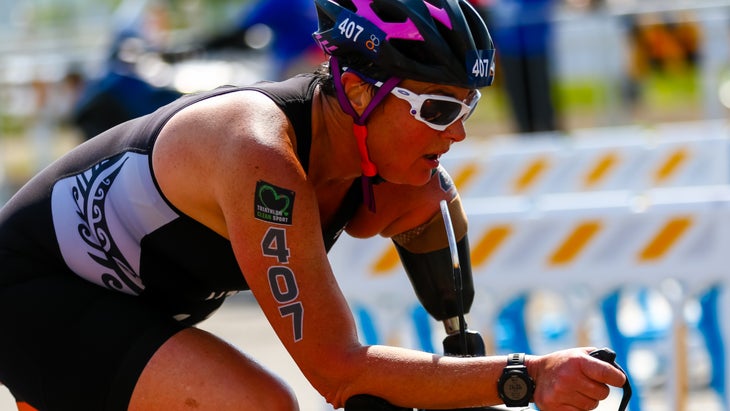
Bicycles
Anyone who knows their way around a time trial bike will be familiar with the bikes used by paratriathletes because there is little to no difference.
Depending on their impairment, a paratriathlete may use an aero road frame for comfort, but in the non-drafting format, top-end time-trial bikes will be commonplace for those competing in Tokyo.
“It’s been by far the biggest change since Rio,” Riall explained. “The athletes have just smartened up to the kit. One by one every athlete is on a very good bike. In paratriathlon we have to be honest and admit the capacity we have to buy gear is critical.”
Estimated cost: $7-9K
PTVI – Visually-impaired and blind triathletes
Tandem
The tandem for the visually impaired paratriathletes has evolved greatly over the years.
“There’s a huge amount of force going through a tandem, and if there’s any flex in the frame, you’ll notice it straightaway,” Riall said. “Two big guys coming out of a dead turn and putting down 700 watts is a lot. They tend to brake a lot too!”
Fewer brands have invested in this more niche market and Riall said British Triathlon has gone through “three chapters” with tandems. They started with British company Dolan, known for producing reliable alloy frame bikes, before moving to Taiwanese brand Matrix, who made carbon frame bikes with alloy joints for the saddles and bottom bracket.
More recently GB—and many rival nations—have upgraded to French brand, Cyfac, who custom-make Kevlar-laminated carbon frames.
The front end is built into a bespoke time trial cockpit for the guide, with the rear rider normally using a set of drops, although some athletes have started to experiment by making the tandem as long as possible and using two sets of time trial bars.
Estimated cost: $13-15k
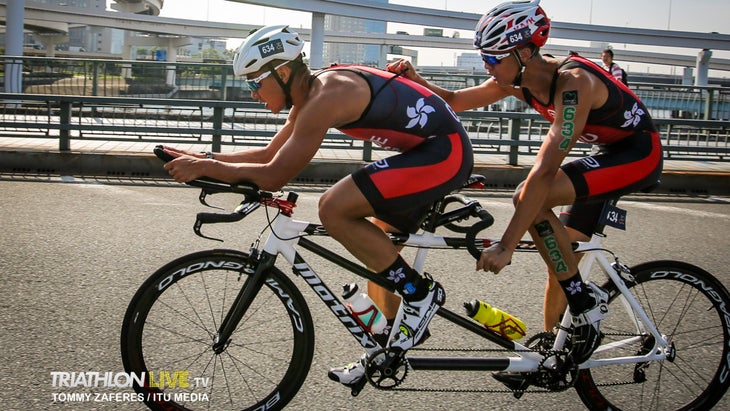
Tether
A final piece of gear, and finally an inexpensive piece of gear!
“Shoelaces are still top priority!” Riall said of the tether that helps the guide escort his or her VI paratriathlete around the course. During the swim, it’s often two elastic laces which might attach at the ankle or calf of the guide and thigh of the blind athlete.
“For the run it’s often a shoelace with a couple of loops,” Riall explained. “Just long enough to allow athletes to run freely. Any leading around corners is always done through touch.”
Estimated cost: $5
